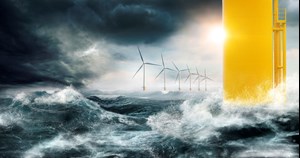Glass flake coatings could mean end to offshore wind substructure surface maintenance
Glass flake polyester (GFP) coatings offer more than 30 years’ maintenance-free corrosion protection at the splash zone for offshore assets, according to a new independent report from classification society DNV.
The study shows that Baltoflake, a GFP solution developed by leading coatings manufacturer Jotun, provides decades of protection for offshore wind substructures and reduces lifecycle costs by up to 50%.
The high-performance coating is ideal for deployment in the offshore wind sector, where strong corrosion resistance and excellent mechanical properties are required.
DNV inspected a section of jacket from a North Sea oil platform which was installed in 1972 and decommissioned in 2020. Jotun’s Baltoflake coating was applied to the platform in the late 1980s and, despite over 30 years’ exposure to the North Sea’s harsh environment, analysis revealed that the coating at the splash zone was intact, still smooth and showing no signs of delamination.
Ismail Tan, Global Category Manager - new construction primers, at Jotun said: “Although glass flake coatings have been used in the energy industry for over 40 years, there has traditionally been very little research into the material’s long-term benefits. However, by partnering with DNV on this report, we now have the relevant in-field data required to demonstrate Baltoflake’s full asset lifecycle protection performance.
“Baltoflake removes the requirement for offshore wind developers to undertake expensive repairs or replacement due to corrosion. By reducing overall maintenance costs and downtime, we can empower operators to focus their efforts on clean energy generation.”
According to recent figures, global installed offshore wind capacity is expected to reach 630 gigawatts (GW) by 2050, up from 40 GW in 2020.
However, with global steel stocks and production declining following the pandemic, and with the war in Ukraine locking out around 10% of the global steel trade, the cost of steel is skyrocketing while availability drops, putting pressure on offshore wind projects.
Offshore wind developers are at an increased risk of rising prices due to the large turbine sizes, longer foundation structures and substation requirements. However, with offshore turbines designed to last for 20-25 years, solutions like Baltoflake have the potential to extend the life of new and existing turbines by more than 10 years, reducing lifecycle costs by 50% in the process.
Introduced during the 1970s, Baltoflake was one of the first performance coating products targeted for offshore environment deployment. The coating has glass flake materials incorporated into polyester to create structure that is 5–20 times more impermeable than resin alone.
Glass flake coatings have an outstanding corrosion resistance to a wide range of acids, alkalis, solvents and salt solutions, whilst displaying excellent thermal stability.
With decades of experience protecting assets in the harshest environments, Jotun, headquartered in Sandefjord, Norway, is a world leader in coatings for offshore structures. The company has developed high performance coatings for the offshore industry for more than 50 years.
The report will be launched at this year’s ONS exhibition in Stavanger where Jotun can be found at booth 7540.



